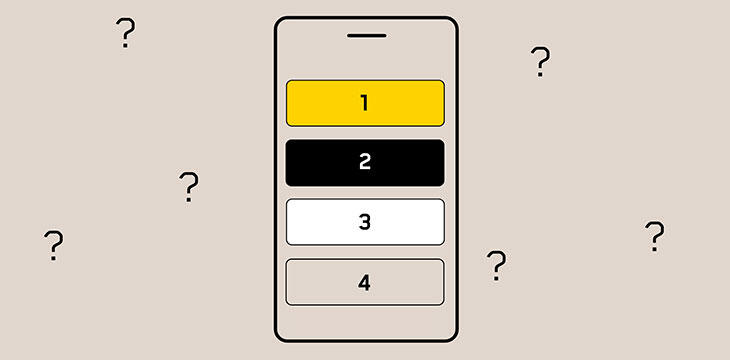
For employees, changing mobile devices is both a smart move as well as a fun one. It’s a great opportunity to spoil yourself! But for managers, it can become a headache. With all the different models and plans offered, mobile for business can take many forms. What’s key is knowing how to adapt to everyone’s needs.
It's not very realistic to think that a phone provided by an employer will only be used in a strictly professional context. Simply take a look at all the people sitting on patios at restaurants, in parks, or even at the beach, and you’ll notice that mobile plays a bigger role than simply being a work tool. People identify with their phones—so much so that a growing number of employees prefer to bring their own device to work instead of letting their employer choose their device for them.
That doesn’t mean mobile management is less important. Rather it’s evolving and allowing more room for employees so that their private and professional lives can harmoniously coexist on the same device, which is something that’s everybody’s business: bosses, IT managers, and users.
In the case of personal devices brought in by employees or corporately reimbursed plans and devices, the challenge faced by employers is implementing a company mobile management policy. In such cases, zero-touch deployment management tools, such as DEP and Mobile Device Management, become essential in terms of operationalizing and managing in all simplicity.
Employers have three options when it comes to mobile management :
- Lines (plans and devices) paid for by the company
- Lines (plans) paid for by the company, but with employees’ personal devices (paid for by the employees themselves)
- Lines (plans and devices) paid for by the employees and reimbursed in part or in whole by the company (“corporately reimbursed”)
BYOD: Yes or yes?
It’s been a trend for the past five years and shows no signs of quitting: More and more employees want to be able to shop for their own mobile devices and simply plug them into their companies’ networks.
In short, the trend of bringing your own device (BYOD) is now part of the mobility solutions companies need to offer if they are counting on making their workforce more… mobile.
And that’s not really a bad thing, because other statistics published by American firm Frost and Sullivan indicate that leaving employees to choose their mobile devices themselves benefits employers in more ways than one. First, it makes them more productive. Every day, this increased mobility reduces time spent doing tasks other than their job by 58 minutes, on average. That translates into a 34 percent increase in productivity.
It also reduces the costs of managing a fleet of mobile devices fairly substantially. California tech supplier Cisco recently calculated that every employee who arrived at work with their own mobile device in their pocket enabled their employer to save an average of $350 per year.
In a recent video, Stéphane Leduc, strategic account director with Videotron Business, confirmed the data. “In concrete terms, it’s more or less 25 percent in monthly savings on the cost of mobile services,” he said. “And that leads to a notable reduction in the management needed for a corporate mobile account.”
That doesn’t mean you have to completely abandon mobile management within organizations. On the contrary, mobile management needs to adapt to a different context by adding a bit of flexibility to its operations. Part of the time and money saved in the purchase and management of tools needs to be reinvested, especially in company data access security.
Supervising the use of mobile devices and securing their various functionalities seems simpler when you have total control of these devices, but makers have adapted their products to the BYOD trend. Microsoft, with its Office 365 suite, Google, with its G Suite platform, and Apple, with its iPhone iOS system, all feature IT settings that aim at creating a safe space on employees’ devices, separate from their personal content. This space, reserved for professional apps and company data, can be managed remotely, and even allows the IT department to configure a new device without needing to have it physically in-hand.
Good to know
Industry figures on the subject speak volumes: One North American employee in two believes they would work more effectively if they could use their own device instead of the one provided by their employer. That ratio climbs to almost two workers in three (61%) for those 30 years of age and under.
Mobility beyond devices
Allowing employees to choose their own mobile devices shifts management towards applications and services through which users have access to tools and data related to their work. Tech support may no longer need to handle cases where an employee’s phone smashes after being dropped on the ground, but they’ll need to respond to other kinds of requests, explains Yanick Proulx, senior director of revenue growth and mobile development at Videotron Business.
“Managing a company’s fleet of devices was quite a headache. Before, when a device was broken, it had to be replaced immediately,” he says. Now the user is responsible for their mobile phone, but expectations on the part of the employer haven’t diminished, they’ve simply changed.
“Mobile phones are ubiquitous. People keep them with them at all times and expect to be able to do everything with it. That can extend to even replacing their access card with a mobile app,” continues Proulx in a webinar on corporate mobility he hosted on behalf of Fibrenoire.
Good to know
Mobility management needs to change, advised the expert, especially since mobility tools offered by companies will often vary from one type of employee to another, depending on their role or responsibilities within the organization. “We’re realizing more and more that there’s no single formula for mobility management within businesses. Sometimes, leaders within the same company don’t all have the same goals for mobility integration. Is it a productivity tool? A hiring incentive? What we see is that devices are evolving slowly, but above all it’s applications and services that are making all the difference.”
The same process more common in the IT and Internet department is being applied here to the mobile environment: Cloud computing and Web services, the same technologies that make remote work possible, are becoming the central element in enterprise mobility, with employees being free to choose their own device while still knowing they can connect their work tools irrespective of the exact make and model of their phone.
A service agreement that’s good for both employee and employer
Whether you’re buying a phone for personal needs or professional activities, everyone has noticed an increase in prices for new devices in the last few years. For many purchasers, it makes service agreements more attractive, because they regularly offer rewards that translate into credits applicable to the purchase of a new device.
These service agreements are also more flexible, for customers that have increasingly diverse needs. Coverage improves and borders disappear, with roaming options that are valid at the national and even international level, and plans that can be customized depending on the user’s needs.
For companies that don’t have to amortize the cost of devices, the expense is obviously lower since it only includes the cost of services. In some cases, that can translate into a reduction of 10 to 20 percent in monthly payments, in addition to avoiding the fairly major expense of equipment purchase. Major companies have also noticed an optimization in their IT resources, which can now focus on operations that are more crucial to business development.
For the employee’s part, they can choose a device that best suits their lifestyle. Especially since that’s often what it’s all about, states Proulx. “There’s a lifestyle variable at play when getting your own phone. It’s what explains the success of certain manufacturers, or certain models, even if they’re more expensive.”
And it’s not just the price of the phone itself. Purchasers often consider the accessories that are sold with the device, a detail that shouldn’t be neglected by employers because, in some cases, those accessories require a network connection themselves in order to work. Such is the case with some smartwatches, for example.
“Until now, mobility has meant spending most of your time on a phone, through which all other devices connect to a Web service or mobile application, but that’s changing,” concludes Proulx. During the COVID-19 lockdown, many remote workers have come to this realization with other communication tools that will rupture the traditional model of enterprise mobility.
Changing habits, constantly evolving
The general adoption of software like Teams, from Microsoft, messaging app WhatsApp, or even video call services like Zoom illustrate to what extent employees’ habits can quickly and massively change, often with little notice. Companies that adequately manage their mobility have probably not had any big changes to make to their mobile services in order to adapt to these new practices.
If there’s a big trend that best defines enterprise mobility in 2020, it’s that people want to stay in touch whenever and wherever they are, as if they were in the office sitting at their desk. Companies that are accustomed to managing fleets of mobile devices need to adjust since the most popular tools, like those mentioned above, enable employees to keep in touch even remotely, but require licensing fees that are added to the already existing costs of more traditional mobile services.
By allowing employees to bring their own devices, it becomes easier for an organization to make room in its budget for mobile costs that are linked more to its daily operations than to an equipment expense.
On the technology side, this also prepares the organization for transformations that are coming in the mobile world, such as the gradual deployment of next-generation wireless networks. This deployment will happen progressively and will vary from one region to another around the world, including Québec.
Ironically, the change to our work habits promised by these new networks has already started: remote working, virtually always-on connectivity to work activities, access to a wealth of tools, and work applications, not to mention changes to your everyday life outside the office.
“Today, cellphones have become much more than just a communication tool. It’s a wayfinding tool, a tool for creativity, for payments… It’s even a pocket flashlight!” concludes Proulx, illustrated by the fact that mobility, even when initiated on the part of the business, represents a lot more than a mere business solution. For many people, it’s also a personalization tool that can define their chosen lifestyle.
Thankfully, enterprise mobility is also turning out to be more and more easy to personalize, depending on the organization’s needs and goals, while still keeping in mind employees’ own desires. The BYOD trend launched a few years ago continues to transform business mobile services even today. Yet this is only the start of an evolution that first began in the mobile industry, but which will come to affect companies in all sectors of activity, if it hasn’t already.
26 June 2020, By Videotron Business






